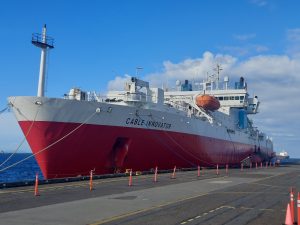With each passing month, Taiwan’s global economic profile rises. The latest flurry of enthusiasm was set off by the return of the island’s long-departed native son, Nvidia founder Jensen Huang, who visited for the Computex tech confab in June.
More than just a photo-op, Huang’s trip provided a chance to meet face-to-face with Morris Chang, the founder of TSMC, the world’s semiconductor hegemon and a company with which Nvidia works symbiotically to produce the chips that are powering the AI revolution. Without TSMC, and without the Taiwanese economic ecosystem in which it thrives, Nvidia would be nowhere near the $3 trillion valuation threshold that it recently crossed. For Nvidia, Apple, and countless other global tech companies, Taiwan is an indispensable player.
In parallel to Taiwan’s economic rise, however, geopolitical risks have been mounting. Following the inauguration of Taiwan’s new president, Lai Ching-te, China has escalated its pressure campaign to break Taiwan’s spirit. In late-May, it executed a 48-hour military exercise called “Joint Sword-2024A,” in which the People’s Liberation Army Navy encircled Taiwan, positioning warships just off the island’s east coast for the first time. According to official statements, the exercise was intended to “serve as a strong punishment for the separatist acts of ‘Taiwan independence’ forces and a stern warning against the interference and provocation by external forces.”
While a brazen military attack of the sort China’s naval and aerial maneuvers threaten cannot be ruled out, the potential for such a scenario is overshadowing a more immediate risk from China’s “grayzone” tactics, often carried out against both Taiwanese and Philippine civilian targets by the China Coast Guard and informal maritime militias. For Taiwan, sabotage perpetrated against the undersea cables that connect its economy to the wider world is a specific and unacceptable vulnerability – indeed, one that China has likely already exploited.
In February 2023, a Chinese vessel ostensibly fishing near the outlying Taiwanese island of Matsu severed one of the two cables that connect it to the main island; six days later, a second Chinese vessel cut the other. As the American Enterprise Institute’s Elisabeth Braw noted for Foreign Policy at the time, “it’s not uncommon for undersea cables to be damaged – but losing two in a row is either really unfortunate or quite possibly not a coincidence.” The damage left the outlying island without effective internet communication for more than two months until repairs could be performed.
While Jensen Huang was able to travel for some face time, the vast majority of the international business Taiwan does relies on the 14 undersea fiber-optic internet cables that link the island with partners around the Pacific Rim and across the globe. When Nvidia, headquartered in California, makes an update to its designs for the chips TSMC etches out, it doesn’t book Huang a plane ticket across the ocean, it transmits the data through the cables that run along the ocean floor.
Surprising though it may be, undersea cables are generally the province of private companies, with American firms like Meta and Google working at the leading edge to connect the world of data. In March of this year, Google began constructing an undersea cable to connect Taiwan, the Philippines, and Guam, one of four it plans for Taiwan in the coming years as part of the firm’s broader global cloud infrastructure program. But if acts of likely sabotage such as those that isolated Matsu last year and more daring provocations like the Joint-Sword exercise become more frequent, it is reasonable to question whether private companies will continue providing Taiwan with the quality cable infrastructure it needs to stay at the top of the tech heap.
Alongside its plan to expand satellite communication fallback options, the Taiwanese government ought to consider playing a stronger role in cable security itself to provide the island with the speed, reliability, and capacity it needs. The first step is to upgrade the cables’ status to that of “critical infrastructure.” Such an upgrade would unlock special funding and resources to keep the cables safe and the data flowing. Taiwan National Security Bureau Director-General Tsai Ming-yen urged such a policy in May, just prior to Lai’s start.
Another perhaps costlier option is for the Taiwanese government to buy its own repair ships to head off the possibility of weeks-long waits like Matsu suffered. At this time, Taiwan must rely on international third parties for repairs. With only 22 cable ships available to service the more than 500 cables that traverse the world’s seas, delays are almost inevitable. An enticing choice would be to purchase a ship like the United Kingdom’s Multi Role Ocean Surveillance Ships (MROSS) – tailor-made for protecting undersea infrastructure like cables. A new MROSS would likely cost Taiwan more than $100 million and take years for delivery, but Taiwan could try to procure an older ship and seek to extend its lifespan.
Taiwan is at the forefront of global technological development. By virtue of its chip industry, it is almost a clearinghouse for the latest in computing and gadgetry. To remain at the leading edge – and to keep Jensen Huang from stuffing designs into his carry-on – Taiwan should put more resources into securing its undersea cables.

































